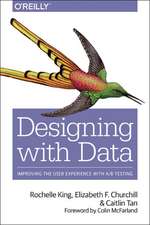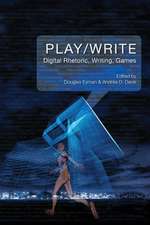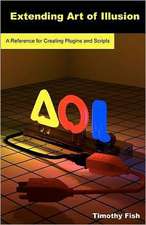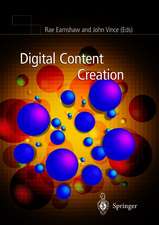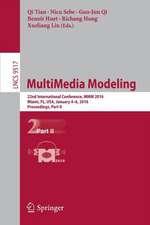State of the Art in Computer Graphics: Visualization and Modeling
Editat de David F. Rogers, Rae Earnshawen Limba Engleză Paperback – 19 oct 2011
| Toate formatele și edițiile | Preț | Express |
|---|---|---|
| Paperback (2) | 649.60 lei 6-8 săpt. | |
| Springer – 19 oct 2011 | 649.60 lei 6-8 săpt. | |
| Springer – 10 sep 2013 | 988.66 lei 6-8 săpt. | |
| Hardback (2) | 659.97 lei 6-8 săpt. | |
| Springer – 3 iun 1991 | 659.97 lei 6-8 săpt. | |
| Springer – 16 dec 1993 | 991.60 lei 6-8 săpt. |
Preț: 649.60 lei
Preț vechi: 812.01 lei
-20% Nou
Puncte Express: 974
Preț estimativ în valută:
124.31€ • 132.92$ • 103.64£
124.31€ • 132.92$ • 103.64£
Carte tipărită la comandă
Livrare economică 18 aprilie-02 mai
Preluare comenzi: 021 569.72.76
Specificații
ISBN-13: 9781461287742
ISBN-10: 146128774X
Pagini: 380
Ilustrații: V, 368 p.
Dimensiuni: 155 x 235 x 20 mm
Greutate: 0.53 kg
Ediția:Softcover reprint of the original 1st ed. 1991
Editura: Springer
Colecția Springer
Locul publicării:New York, NY, United States
ISBN-10: 146128774X
Pagini: 380
Ilustrații: V, 368 p.
Dimensiuni: 155 x 235 x 20 mm
Greutate: 0.53 kg
Ediția:Softcover reprint of the original 1st ed. 1991
Editura: Springer
Colecția Springer
Locul publicării:New York, NY, United States
Public țintă
Professional/practitionerCuprins
1 Hardware/Parallel Processing.- Graphics Algorithms for Parallel Machines.- Evolution of 3D Graphics Architectures.- 2 Image Generation.- Radiosity.- Interpolation for Polygon Texture Mapping and Shading.- Random Processes in Computer Graphics.- 3 Modeling.- Supporting Complexity and Conceptual Design in Modeling Tools.- Combinatorial Solid Geometry, Boundary Representations, and n-Manifold Geometry.- Rational B-spline Curves and Surfaces for CAD and Graphics.- 4 Graphical User-Computer Interfaces.- Software Tools for Designing and Implementing User-Computer Interfaces.- 5 Visualization.- Volumetric Visualization Techniques.- Biographies.
Descriere
Descriere de la o altă ediție sau format:
State of the Art in Computer Graphics Aspects of Visualization This is the fourth volume derived from a State of . . . the Art in Computer Graphics Summer Institute. It represents a snapshot of a number of topics in computer graphics, topics which include visualization of scientific data; modeling; some aspects of visualization in virtual reality; and hardware architectures for visu alization. Many papers first present a background introduction to the topic, followed by discussion of current work in the topic. The volume is thus equally suitable for nonspecialists in a particular area, and for the more experienced researcher in the field. It also enables general readers to obtain an acquaintance with a particular topic area sufficient to apply that knowledge in the context of solving current problems. The volume is organized into four chapters - Visualization of Data, Modeling, Virtual Reality Techniques, and Hardware Architectures for Visualization. In the first chapter, Val Watson and Pamela Walatka address the visual aspects of fluid dynamic computations. They discuss algorithms for function-mapped surfaces and cutting planes, isosurfaces, particle traces, and topology extractions. They point out that current visualization systems are limited by low information transfer bandwidth, poor response to viewing and model accuracy modification requests, mismatches between model rendering and human cognitive capabilities, and ineffective interactive tools. However, Watson and Walatka indicate that proposed systems will correct most of these problems.
State of the Art in Computer Graphics Aspects of Visualization This is the fourth volume derived from a State of . . . the Art in Computer Graphics Summer Institute. It represents a snapshot of a number of topics in computer graphics, topics which include visualization of scientific data; modeling; some aspects of visualization in virtual reality; and hardware architectures for visu alization. Many papers first present a background introduction to the topic, followed by discussion of current work in the topic. The volume is thus equally suitable for nonspecialists in a particular area, and for the more experienced researcher in the field. It also enables general readers to obtain an acquaintance with a particular topic area sufficient to apply that knowledge in the context of solving current problems. The volume is organized into four chapters - Visualization of Data, Modeling, Virtual Reality Techniques, and Hardware Architectures for Visualization. In the first chapter, Val Watson and Pamela Walatka address the visual aspects of fluid dynamic computations. They discuss algorithms for function-mapped surfaces and cutting planes, isosurfaces, particle traces, and topology extractions. They point out that current visualization systems are limited by low information transfer bandwidth, poor response to viewing and model accuracy modification requests, mismatches between model rendering and human cognitive capabilities, and ineffective interactive tools. However, Watson and Walatka indicate that proposed systems will correct most of these problems.





